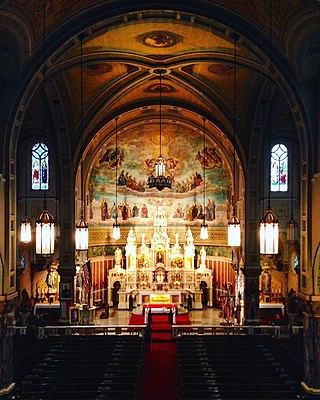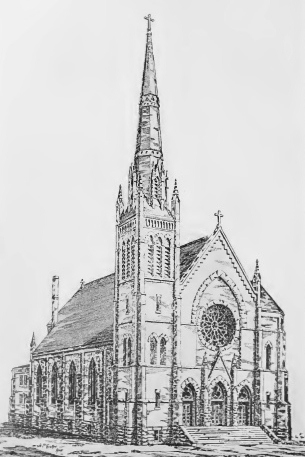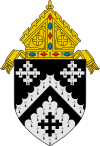
The Diocese of Youngstown is a Latin Church ecclesiastical territory, or diocese, of the Catholic Church in northeastern Ohio in the United States. It is a suffragan diocese in the ecclesiastical province of the metropolitan Archdiocese of Cincinnati.

The Diocese of Cleveland is a Latin Church ecclesiastical territory, or diocese, of the Catholic Church in northeastern Ohio in the United States. As of September 2020, the bishop is Edward Malesic. The Cathedral of St. John the Evangelist, located in Cleveland, is the mother church of the diocese.

Richard Gerard Lennon was an American prelate of the Roman Catholic Church. He served as bishop of the Diocese of Cleveland in Ohio from 2006 to 2016. He previously served as an auxiliary bishop of the Archdiocese of Boston in Massachusetts from 2001 to 2006.

St. Mary of Częstochowa in Cicero is an historic church of the Archdiocese of Chicago located in Cicero, Illinois.

St. Joseph's is a historic church of the Roman Catholic Archdiocese of Chicago located in Chicago, Illinois at 4821 South Hermitage Avenue. Founded in 1887 with the current church building dating to 1914, Saint Joseph's is a prime example of the Polish Cathedral style of churches in both its opulence and grand scale. Along with St. John of God and Holy Cross, it is one of three monumental religious edifices that dominates the skyline of the Back of the Yards neighborhood. The parish survived archdiocesan budget cuts in 1990, and, in 2021, was merged with several local churches into a single parish. Today, St. Joseph serves a multicultural community.


The Shrine Church of St. Stanislaus is the home of a Catholic parish within the Diocese of Cleveland. St. Stanislaus is one of the major historic centers of Polish life in Cleveland, Ohio, especially for Poles with roots in Warsaw and surrounding areas, and is often called the mother church for Cleveland's Polish population. The shrine is located at the intersection of Forman Ave. and East 65th St., in a part of the South Broadway neighborhood previously known as Warszawa; today the area is known as Slavic Village. The church, the neighborhood, and the larger surroundings are GNIS named features.

St. Michael the Archangel Church is a former Roman Catholic church located at 2110 St. Michael Street, in Cincinnati, Ohio. The cornerstone of this church was laid in 1847 and the church dedicated a year later. The church closed April 5, 1998.

Ignatius Frederick Horstmann was an American prelate of the Roman Catholic Church. He served as bishop of the Diocese of Cleveland in Ohio from 1892 until his death in 1908.

St. Mary's Catholic Church was a parish of the Diocese of Davenport. The church building is located in the west end of Davenport, Iowa, United States, at the corner of Fillmore and W. 6th Streets. It is listed on the National Register of Historic Places as St. Mary's Roman Catholic Church Complex. The designation includes the church building and rectory on the west side of Fillmore Street, and the former parochial school building and convent on the east side. A former school building operated by the parish two blocks north on West Eighth Street is also on the National Register and is listed as St. Mary's Academy. The parish ceased operations in July 2020 when it was merged into St. Anthony's Church downtown. The parish campus is being acquired by the nonprofit organization Humility Homes & Services, which is operated by the Congregation of the Humility of Mary.

St. Elizabeth of Hungary Shrine is a historic Roman Catholic shrine in the Buckeye Road neighborhood on the east side of Cleveland, Ohio, United States. The earliest ethnic parish established for Hungarians in the United States, its present building was constructed in the early twentieth century, and it has been named a historic site. In 2023, it was declared a shrine church by Bishop Edward Malesic for the exclusive celebration of the Tridentine Mass and is presently operated by canons of the Institute of Christ the King Sovereign Priest.

St. Stephen Church is a Roman Catholic church located in the Detroit-Shoreway neighborhood on the west side of Cleveland, Ohio. The gothic style building was designed by architects Cudell & Richardson. The current church was built in 1875 and was added into the National Register of Historic Places in 1977.

St. Mary's on the Flats, originally known as the Church of Our Lady of the Lake, was the first Catholic church building in Cleveland, Ohio. The location where the church once stood can be found, in an 1881 atlas, at the south-east corner of Columbus Ave. and then Girard Ave. on the east bank of the Cuyahoga river in the flats. Irishtown Bend Archeological District, where many of the parishioners lived, lies to the west, across the Cuyahoga river in what was Ohio City. Ohio City was annexed by Cleveland on June 5, 1854.
Immaculate Heart of Mary Church, is a Catholic parish church in Cleveland, Ohio and part of the Diocese of Cleveland. It is a located on Lansing Ave. near East 66th St., in a part of the South Broadway neighborhood previously known as Warszawa, also referred to today as Slavic Village. Both the church and the area are GNIS named features. The church is in the neighborhood of, but not within, the area listed as Warszawa Neighborhood District on the National Register of Historic Places. The church, school, rectory, and convent buildings are listed together as a Cleveland Designated Landmark.

The Basilica of Regina Pacis is a Catholic parish church located in the Bensonhurst section of Brooklyn, New York, under the Roman Catholic Diocese of Brooklyn. The church was built as a votive shrine, within the then-Parish of St. Rosalia. The original parish church, built in 1905, was considered the "Mother Church of Italian immigrants" of the diocese.

Saint Casimir Church is a Catholic parish church in Cleveland, Ohio, and part of the Roman Catholic Diocese of Cleveland. It is designated "a personal parish for those Catholics of the Latin Rite of Polish descent" in Cleveland. A personal parish is designated under Canon 518 of the 1983 Code of Canon Law. It is located at the north-east corner of intersection of East 82nd St. and Sowiniski Ave., in a part of the St. Clair-Superior neighborhood previously known in Polish as na Poznaniu.
St. Barbara Catholic Church is a parish of the Roman Catholic Church in Cleveland, Ohio, within the Diocese of Cleveland. The parish church is located on Denison Ave. between West 16th St. and the southbound entrance to SR 176, in a part of the Brooklyn Centre neighborhood previously known in Polish as na Barbarowie.
St. Peter Church, is a Catholic parish church in Cleveland, Ohio and part of the Diocese of Cleveland. Founded in 1853, it is located at the intersection of Superior Ave. near East 17th St., in the Downtown neighborhood.

Annunciation Church (historic) (French: Église de l'Annonciation de Cleveland), was a Catholic parish church in Cleveland, Ohio and part of the Diocese of Cleveland. It was located at the intersection of Hurd St. and Moore St., now part of the West Side Market parking lot, in the Ohio City neighborhood. The location where the church once stood can be found, in an 1881 atlas, at the south-west corner of Hurd St. and Moore St., on the west bank of the Cuyahoga river above part of the Flats historically known as Ox Bow Bend. It was located about 1,560 ft (480 m) walking distance from St. Mary's on the Flats, the first Catholic church in Cleveland and about 150 ft (46 m) distance from the present St. Emeric Church.
Transfiguration Church, was a Catholic parish church in Cleveland, Ohio, in the United States. Part of the Roman Catholic Diocese of Cleveland, it was located at the southwest corner of the intersection of Broadway Avenue and Fullerton Avenue in a part of the South Broadway neighborhood previously known in Polish as Warszawa, also referred to today as Slavic Village. The church suffered a severe structure fire in 1990. The parish closed in 1992, and the church was demolished in early 1993. The records of this church, and all churches closed after 1975, can be found in the Catholic Diocese of Cleveland Archives. Diocesan policy is to keep all archive records closed.




















